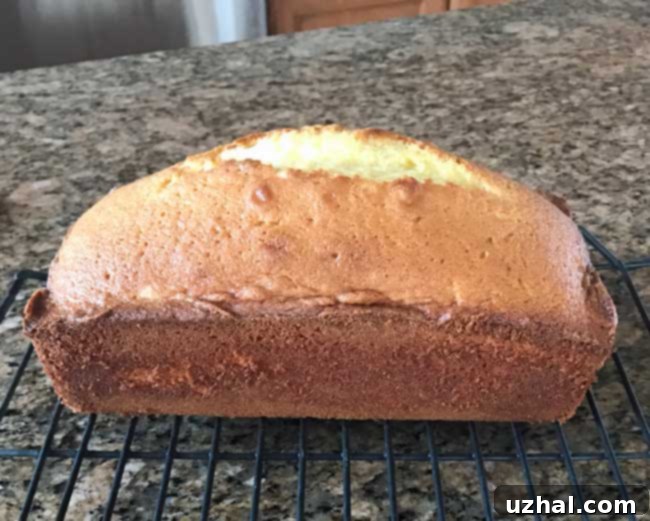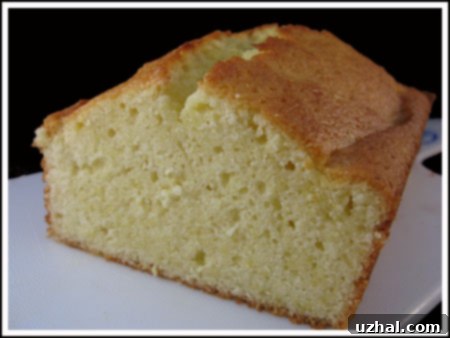The Ultimate Easy Lemon Loaf Cake Recipe: A Zesty Delight from Baking with Julia
There’s something inherently delightful about a truly well-made lemon loaf cake. It’s a dessert that perfectly balances sweet and tart, light and dense, making it ideal for any occasion – from a casual brunch to an elegant afternoon tea. While countless lemon cake recipes exist, our focus today is on a particularly exceptional version: the Lemon Loaf Cake from Baking with Julia. This recipe stands out for its impressive rise, its incredibly tender crumb, and the ingenious use of both cake flour and a rich blend of melted butter and heavy cream. What makes it even more appealing for home bakers is its delightful simplicity – unlike many elaborate cakes, this one doesn’t even require an electric mixer, making it accessible to even beginner bakers. While it might take a little more care and attention than a boxed mix like the Duncan Hines Lemon Pound Cake, the superior flavor and texture achieved are well worth the minimal extra effort. Prepare to fall in love with a homemade lemon cake that’s both elegant and wonderfully easy to achieve.

Unlocking Maximum Lemon Flavor: The Zest Secret
One of the true secrets to a vibrant, intensely flavored lemon loaf cake lies in how you handle the lemon zest. This recipe calls for the zest of several large lemons, and here’s where a small but impactful technique comes into play. Instead of simply adding the grated lemon zest directly to the batter, we recommend a method that truly infuses the sugar with that bright, citrusy aroma. By combining the finely grated lemon zest with the sugar and rubbing it together with your fingers or the back of a spoon, you help burst the tiny cells in the zest, releasing its precious essential oils directly into the sugar crystals. This creates a beautifully fragrant, lemony sugar that will distribute its flavor more evenly and intensely throughout your cake batter, ensuring every bite is packed with sunshine.
While I can’t definitively quantify if this technique extracts more essential oils than simply adding the zest, the sensory experience alone is enough to convince me. The intoxicating aroma that fills your kitchen as you rub the zest into the sugar is unparalleled, and it certainly feels like you’re coaxing every last bit of lemon goodness into your ingredients. For this crucial step, a good quality Microplane zester is an indispensable tool. It allows you to get finely grated zest without including any of the bitter white pith that lies underneath the brightly colored skin. This small act of culinary magic sets the stage for a lemon loaf cake that truly sings with authentic citrus flavor, distinguishing it from ordinary lemon-flavored bakes.

The Perfect Crumb: Richness Without the Fuss
The final result of this lemon loaf cake recipe is nothing short of exceptional. This cake boasts a wonderfully tight and dense crumb, reminiscent of a classic, perfectly creamed pound cake, yet it achieves this luxurious texture with a fraction of the effort. The strategic use of cake flour, which is lower in protein and creates a more tender and delicate result, combined with the richness of melted unsalted butter and heavy cream, contributes to a moist, velvety interior that simply melts in your mouth. You’ll find it significantly simpler to prepare than many traditional pound cake recipes that rely on extensive creaming methods, yet it delivers a comparable, if not superior, level of indulgence and flavor.
The beauty of this lemon cake also lies in its inherent versatility. While it’s utterly delicious un-iced, allowing the pure lemon flavor and rich, dense texture to shine through, it also eagerly welcomes a simple topping or accompaniment. Traditionally, I love to serve it alongside a generous dollop of freshly whipped cream and a medley of vibrant fresh berries. The creamy coolness of the whipped cream and the tart sweetness of strawberries, raspberries, or blueberries provide a wonderful contrast to the dense, intensely lemony cake, creating a truly exquisite dessert experience. It’s a testament to the cake’s intrinsic quality that it can stand alone as a simple, comforting treat or be elegantly dressed up for a special occasion, adapting effortlessly to your preference.

Elevate Your Lemon Loaf: Glazing and Serving Suggestions
As confirmed by its enduring popularity, this Lemon Loaf Cake is a consistent favorite for excellent reasons. While its inherent flavor is outstanding on its own, a simple glaze can truly elevate its presentation and add an extra layer of bright lemon flavor and complementary sweetness. A thin, tangy lemon glaze, made easily with powdered sugar and fresh lemon juice, can be drizzled artfully over the cooled loaf. This not only adds a beautiful, subtle sheen to the cake but also intensifies the citrus notes, creating an irresistible finish that makes it even more appealing for guests or a special treat.

Beyond the simple glaze, consider experimenting with various accompaniments to enhance your lemon loaf experience. For a delightful breakfast or brunch, a slice of this lemon loaf paired with a freshly brewed cup of coffee or herbal tea provides a comforting and invigorating start to the day. For a more elaborate dessert, here are some ideas:
- Fresh Berries: A vibrant mix of seasonal berries like strawberries, raspberries, and blueberries adds a burst of freshness and a delightful contrasting tartness.
- Whipped Cream: A dollop of lightly sweetened, freshly whipped cream offers a luxurious, airy counterpoint to the dense cake.
- Lemon Curd: For an intense lemon experience, serve each slice with a spoonful of homemade or high-quality store-bought lemon curd.
- Vanilla Ice Cream: A scoop of premium vanilla ice cream can transform this humble loaf into a more substantial and indulgent dessert.
- Candied Lemon Slices: For an elegant and professional touch, garnish your slices with thinly cut, candied lemon slices.
- Nutty Crunch: A sprinkle of toasted slivered almonds or chopped pistachios can add a pleasing texture.
This Lemon Loaf Cake remains one of my absolute favorites, a testament to its consistent deliciousness and remarkable ease of preparation. Whether you savor it plain, with a simple dusting of powdered sugar, or elegantly glazed and served with fresh fruit, it promises a burst of sunshine and comfort in every single bite. Its versatility makes it a staple in any baker’s repertoire, effortlessly transitioning from a morning treat to an evening dessert.
Tips for Baking a Perfect Lemon Loaf Every Time
Achieving a bakery-quality lemon loaf at home is entirely within reach with just a few simple, yet crucial, baking tips. These small details can make a significant difference in the final texture, moisture, and flavor of your cake, ensuring consistent success with every bake:
- Ensure Room Temperature Ingredients: This is a golden rule in baking, especially for cakes. Make sure your eggs, heavy cream, and even the melted butter (after it has cooled slightly) are at room temperature. This allows them to emulsify better with the other ingredients, creating a smoother, more uniform batter and ultimately contributing to a finer, more tender crumb in the finished cake.
- Avoid Overmixing the Batter: After you’ve added the flour and baking powder, mix the batter only until the dry ingredients are just combined. Overmixing develops the gluten in the flour excessively, which can lead to a tough, rubbery, and dry cake. A light hand with the whisk and gentle folding in of the butter are key to maintaining that delicate, moist texture.
- Accurate Zesting is Essential: Use a fine-grated zester like a Microplane to get only the brightly colored outer layer of the lemon peel, which contains all the aromatic oils. Absolutely avoid including any of the bitter white pith directly underneath the zest, as this can impart an unpleasant taste to your delicate lemon loaf.
- Proper Pan Preparation: Always take the time to grease and flour your loaf pan thoroughly. This step is non-negotiable for ensuring your beautiful loaf doesn’t stick to the pan and comes out perfectly intact. For extra assurance, you can also line the pan with parchment paper, leaving an overhang on the sides, to make removal even easier after baking.
- Master the Toothpick Test for Doneness: The toothpick test is your most reliable indicator of doneness. Insert a clean wooden toothpick into the very center of the loaf; if it comes out clean or with just a few moist crumbs attached, your cake is done. If it comes out wet with raw batter, continue baking for a few more minutes, checking again until it passes the test.
- Patient Cooling Process: Allow the cake to cool in the pan for about 10-15 minutes before attempting to transfer it to a wire rack. This initial cooling period allows the cake to firm up and set, preventing it from breaking apart when you unmold it. Once unmolded, cool it completely to room temperature right side up on a wire rack to prevent any sogginess from steam trapped underneath.
By diligently following these foundational baking practices, you’re well on your way to consistently baking a moist, intensely flavorful, and perfectly textured lemon loaf that will impress everyone who tries it.
Recipe

Lemon Loaf Cake
Anna
Pin Recipe
Ingredients
- 1 ⅓ cups granulated sugar (250 grams)
- Grated zest of 3 large lemons
- 4 large eggs at room temperature (200 grams)
- ⅛ teaspoon salt
- 1 ¾ cups cake flour (196 grams)
- ½ tsp. baking powder
- ½ cup heavy cream at room temperature
- 5 ½ tablespoons unsalted butter, melted and cooled to room temperature (80 grams)
Instructions
-
Preheat oven to 350 degrees F (175 degrees C). Thoroughly grease and flour a 9×5 inch loaf pan to prevent sticking.
-
In a large mixing bowl, combine the granulated sugar and the grated lemon zest. Using your fingers or the back of a spoon, gently rub the lemon zest into the sugar for a minute or two. This action helps to release the aromatic essential oils from the zest, infusing the sugar with intense lemon flavor.
-
To the lemony sugar mixture, add the room temperature eggs and salt. Whisk vigorously for just about a minute, until the mixture becomes foamy and smoothly blended. It’s important that the mixture remains liquid and does not thicken substantially at this stage.
-
Spoon the cake flour and baking powder into a sifter. Sift approximately one-third of these dry ingredients over the foamy egg mixture. Using a whisk, lightly incorporate the flour into the eggs, mixing just until streaks disappear. Sift the remaining flour over the eggs in two more additions, whisking gently after each addition until everything is just incorporated. Avoid overmixing. Finally, whisk the room temperature heavy cream into the batter, then carefully fold in the melted butter until no streaks remain.
-
Pour the prepared batter into your greased and floured loaf pan; it should naturally level itself. Bake for 50 to 60 minutes (note: my oven typically requires the full 60 minutes for this recipe), or until the center of the cake crowns, shows slight cracks, and a wooden toothpick inserted into the very center comes out completely clean. Once baked, remove the cake from the oven and place it on a wire cooling rack to rest in the pan for 10-15 minutes before carefully unmolding it. Allow it to cool completely to room temperature, right side up, on the wire rack.
-
Once the lemon loaf is fully cool, wrap it tightly with aluminum foil or plastic wrap to maintain its freshness and moisture. The cake should keep well for 3 or 4 days at room temperature. For extended freshness, it can be refrigerated for up to a week. For even longer storage, individual slices can be wrapped and frozen for up to 3 months; thaw at room temperature or gently warm for a quick treat.
Notes
Why “Baking with Julia” Makes a Difference
The original recipe source, Baking with Julia, is not just any cookbook; it represents a gold standard in culinary education and classic baking techniques. Julia Child, a legendary culinary icon, alongside her expert collaborators, meticulously developed and rigorously tested each recipe to ensure consistent success for home bakers of all skill levels. When a recipe is adapted from such a reputable and celebrated source, it carries with it a legacy of quality, precision, and a promise of a truly well-engineered outcome. This particular lemon loaf cake profoundly benefits from that meticulous approach, providing a structure, flavor profile, and baking process that is both traditional in its excellence and effortlessly perfect in its results. It’s a recipe that deeply respects the fundamental principles of baking while consistently delivering a profoundly satisfying and delightful modern treat that stands the test of time.
Storage Tips for Your Delicious Lemon Loaf
Proper storage is essential to ensure your freshly baked lemon loaf cake stays as fresh, moist, and delicious as possible for an extended period. Once the cake has completely cooled down to room temperature – this is crucial to prevent condensation and sogginess – wrap it tightly in several layers of plastic wrap or aluminum foil. This barrier effectively prevents moisture loss and helps retain its delicate crumb. You can store the wrapped loaf at room temperature for up to 3-4 days, where it will remain wonderfully fresh. If you live in a particularly humid climate, or if you wish to extend its freshness even further, you can refrigerate it for up to a week. For much longer-term storage, the lemon loaf freezes exceptionally well. Simply slice the cooled cake, wrap individual slices securely in plastic wrap, and then place them in an airtight freezer bag or container. These frozen slices can be kept for up to 3 months. To enjoy, thaw them at room temperature for a few hours, or gently warm them in the microwave for a quick, comforting, and delicious treat, tasting almost as good as freshly baked.
- Exploring Baking with Julia: More Recipes and Insights
- Indulge in Julia’s Double Chocolate Cookies
- Discover Julia’s Best Ever Brownies
- A Tropical Twist: White Chocolate Coconut Cream Pie
- Celebrating Julia Child with Special Brownies
